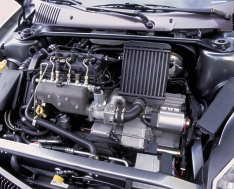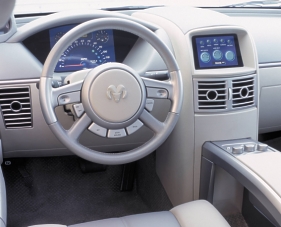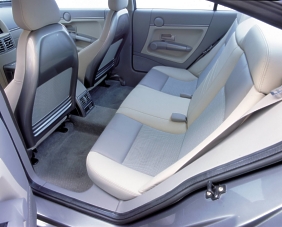
.
. .
..
. . .
Other Dodge
© 1999-2006
Copyright
|
DaimlerChrysler : The Dodge ESX3, low fuel consumption The Dodge ESX3 continues DaimlerChrysler's progress toward an ultra high-mileage family car that pleases passengers at the same time it protects the environment.
all photos: Chrysler/Dodge
"While we've achieved tremendous gains in fuel efficiency with the ESX3, we've put that technology in a dynamic design that is clean and safe, that has the comfort, utility and performance consumers demand - and is closing in on affordability." In fact, with ESX3, DaimlerChrysler engineers and designers have cut the cost penalty for a high-mileage vehicle in half in just two years. The ESX2 from 1998 cost about $15,000 more than a comparable gasoline-powered car; with the ESX3, the cost differential is about $7,500. (The ESX in 1996 carried a cost penalty of $60,000.) The cost associated with fuel-efficient technology remains a hurdle in bringing hybrid propulsion systems to market in volumes, especially in the United States where gasoline prices remain low. Prices of up to five dollars per gallon in Europe and Japan help generate consumer demand for small, efficient vehicles while minivans, pickup trucks and sport-utility vehicles continue to gain popularity among American consumers. "Our challenge is to continue to find innovative ways to improve the fuel efficiency of all our vehicles and pass the fuel savings on to our customers at little or no additional cost," Gale added. "We're excited about our joint efforts to meet these goals through PNGV." The progress in fuel efficiency and cost stem from several major improvements in technology: The ESX3's mild hybrid electric (or "mybrid") powertrain combines a clean, efficient diesel engine, electric motor and state-of-the-art lithium-ion battery to achieve an average 72 miles per gallon (3.3 liters/100 km) fuel efficiency (gasoline equivalent). That is two miles per gallon better than the fuel efficiency of its predecessor, the ESX2 in 1998, and close to PNGV's goal of up to 80 mpg (2.9 liters/100 km). A unique electro-mechanical automatic transmission (EMAT) developed by DaimlerChrysler engineers provides the fuel efficiency of a manual transmission with the convenience of an automatic.
The lightweight body makes use of another DaimlerChrysler innovation - injection-molded thermoplastic technology that achieves significant improvements in weight and cost. The ESX3 weighs in at just 2,250 pounds (1020 kg) while meeting all federal safety standards and providing the roominess and comfort of today's family sedan. The entire vehicle is more than 80 percent recyclable. A total rethinking of the car's electronic and electrical systems cut several pounds from the weight of electronics while providing an ergonomically satisfying system of driver controls, vehicle monitoring and diagnostic indicators, high-performance audio and video systems, and a state-of-the-art telematics package.
In keeping with the goals of PNGV - and with DaimlerChrysler tradition - elements of this advanced technology have already been incorporated into other vehicles. The recently unveiled Dodge Durango hybrid prototype vehicle makes use of advanced powertrain technology to achieve 20 percent higher mileage in a popular sport-utility vehicle. If proposed tax incentives are implemented, DaimlerChrysler could offer an affordable hybrid to consumers within three years. Also, a thermoplastic hardtop will be available on the Jeep®‚ Wrangler for the 2001 model year, while EMAT transmission technology is being developed for future production vehicles. "Our concept cars aren't just interesting exercises for our engineers," said Bernard Robertson, DaimlerChrysler Senior Vice President - Engineering Technologies and General Manager - Truck Operations. "We work hard to get exciting new technology off the shelf and into the showroom as quickly as possible."
The tremendous progress in powertrains and transmissions, lightweight materials and electronics embodied in the ESX3 is emblematic of DaimlerChrysler's international leadership in innovation and advanced technology. This progress also reflects DaimlerChrysler's commitment to environmental stewardship: the company will spend more than $7 billion this year on research and development to address the challenges of being a global leader in the automobile industry. This progress also signifies the success of the government-industry collaboration in PNGV. Through the Partnership, participating automakers have been able to draw on the expertise of their colleagues in the National Laboratories, supplier firms, and universities in pursuit of a common goal - the next generation of vehicles that will satisfy Americans' love of the automobile while meeting the important national goals of energy independence and a cleaner environment. In the Dodge ESX3, DaimlerChrysler has moved significantly closer to its goal: the most advanced environmentally friendly technology packaged in a vehicle that customers will want to drive and can afford to own. Said Robertson: "It's a huge challenge: triple the fuel efficiency, cut emissions even further, yet keep the styling and performance that our customers love - and make the whole package affordable. But with the ESX3, the answers to these challenges are converging on reality."
|
.
|














